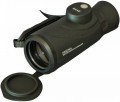Field of view 1 km away
The diameter of the area visible through binoculars / monoculars from a distance of 1 km — in other words, the largest distance between two points at which they can be seen simultaneously from this distance. It is also called "linear field of view". Along with the angular field of view (see below), this parameter characterizes the space covered by the optics; at the same time, it describes the capabilities of a particular model more clearly than data on viewing angles. Models with magnification adjustment (see above) usually indicate the maximum field of view — at the lowest magnification and
the widest angle of view. This information is often supplemented by data on the minimum value.
Real angle of view
The section of the panorama that can be viewed through the eyepieces of binoculars. The higher the actual angular field of view, the wider the visibility of the optics. Note that the angular field of view has an inverse relationship with magnification. That is, the higher the magnification, the narrower the visibility (the smaller the real angular field of view). The actual angular field of view is calculated as follows: you need to divide the angular field of view (in degrees °) by the magnification factor. In comparison, the human eye has an angular field of view of 60 arcseconds (“). In terms of degrees, you get 150 °. Good binoculars provide a real field of view somewhere within 10 arcseconds. But it does not always make sense to chase after large indicators of the real angular field of view. The fact is that when viewing a large section of the panorama, the edges of the image receive noticeable distortion.
Min. focus distance
The smallest distance to the observed object, at which it will be clearly visible through binoculars / monoculars. All such optical instruments were initially created for observing remote objects, therefore, not all of them are able to work at short distances. When choosing a model for this parameter, one should proceed from the expected observation conditions: ideally, the minimum focus distance should not be greater than the smallest possible distance to the observed object.
Eye relief
The offset is the distance between the eyepiece lens and the exit pupil of an optical instrument (see "Exit Pupil Diameter"). Optimum image quality is achieved when the exit pupil is projected directly into the observer's eye; so from a practical point of view, offset is the distance from the eye to the eyepiece lens that provides the best visibility and does not darken the edges (vignetting). A large offset is especially important if the binoculars / monoculars are planned to be used simultaneously with glasses — because in such cases it is not possible to bring the eyepiece close to the eye.
Anti reflective coating
Coating is a special coating applied to the surface of the lens. This coating is intended to reduce light loss at the air-glass interface. Such losses inevitably arise due to the reflection of light, and the antireflective coating “turns” the reflected rays back, thus increasing the light transmission of the lens. In addition, this function reduces the amount of glare on objects visible through binoculars/monoculars. There are
single-layer,
full single-layer,
multi-layer,
full multi-layer. More details about them:
- Single layer. This marking indicates that one or more lens surfaces (but not all) have a single layer of anti-reflective coating applied to them. This is inexpensive and can be used even in entry-level optical instruments. On the other hand, it filters out a certain spectrum of light, which distorts the color rendition in the visible image - sometimes quite noticeably. In addition, in this case, on some lens surfaces there is no coating at all, which inevitably leads to glare in the field of view. Thus, single-layer coating is the simplest type and is used extremely rarely, mainly in budget models.
- Full single layer. A variation of the single-layer coating described above, in which an anti-reflective coating is present on all surfaces of the lenses (at each air-glass interface). Although this option is al
...so characterized by color distortion, it is devoid of another, the most key drawback of “incomplete” enlightenment - glare in the field of view. And the mentioned color distortion is most often not critical. With all this, full single-layer coating is relatively inexpensive, which is why it is very popular in entry-level and entry-mid-level models.
- Multi-layered. A type of coating in which multiple layers of reflective coating are applied to one or more lens surfaces (but not all). The advantage of such a coating over a single-layer coating is that it uniformly transmits almost the entire visible spectrum and does not create noticeable color distortions. The absence of a coating on individual surfaces reduces the cost of the device (compared to full multi-layer coating), but it is impossible to completely get rid of glare in such a system.
- Fully multi-layered. The most advanced and effective of modern types of coating: a multilayer coating is applied to all surfaces of the lenses. This way, high brightness and clarity of the “picture” is achieved, with natural color rendition and no glare. The classic disadvantage of this option is its high cost; Accordingly, full multi-layer coating is typical mainly for high-end models.Prism material
Material used for prisms found in binoculars and monoculars.
-
BK-7. A type of borosilicate optical glass (6LR61), a relatively inexpensive and at the same time quite functional material that provides, although not outstanding, quite acceptable image quality. Used in entry-level and mid-level models.
—BaK-4. Barium optical glass, noticeably superior to BK7 in brightness and image clarity, is however also more expensive. Accordingly, it is found mainly in the premium segment.

